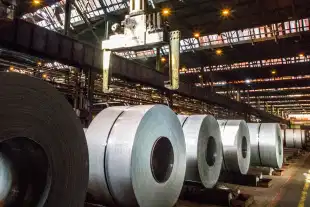Economy
Centre Reviews Steel Policy As Carbon Tariffs Threaten India’s Dream To Become A Global Steel Power
Swarajya Staff
Aug 20, 2024, 12:51 PM | Updated 01:16 PM IST
Save & read from anywhere!
Bookmark stories for easy access on any device or the Swarajya app.


The Ministry of Steel has initiated a review of the seven-year-old National Steel Policy (NSP) to develop a comprehensive decarbonisation strategy.
This move comes in response to the European Union’s (EU) introduction of the Carbon Border Adjustment Mechanism (CBAM), which aims to impose taxes on carbon-intensive products entering the EU from 2026.
The objective of the review is to assess the impact of the current policy on steel production and consumption and to determine if any adjustments are necessary in light of emerging global challenges.
"We are reviewing the NSP 2017 and working on stainless steel and green steel policy," an Economic Times report quoted a steel ministry official saying.
Green steel, in simpler terms, refers to steel produced with low carbon emissions.
Official data reveals that the domestic steel sector contributes 12 per cent of India’s greenhouse gas emissions, with an emission intensity of 2.55 tonnes of CO2 per tonne of crude steel produced, compared to the global average of 1.9 tonnes.
Under the National Steel Policy, India aims to scale up its annual crude steel production capacity to 300 million tonnes by 2030 to meet domestic demand.
As India steadily expands its steel-making capacity to become a global leader, the Western world is shifting its focus towards ‘green steel’ — a catch being that India has yet to prioritise the new, though costlier, technologies that burn less fossil fuel.
Meanwhile, steelmakers in the United States and Europe are transitioning towards green steel production to meet net-zero emission targets and address climate change.
Analysts warn that this divergence in goals — India’s ambition to become the largest steel producer using coal-burning furnaces and the Western world’s shift towards electric and gas furnaces — could create challenges for Indian exports. Indian steel could be perceived as a product of a polluting system, leading to potential trade barriers that could restrict access to lucrative markets.
India is reportedly among the top eight countries most adversely affected by the CBAM.
A Global Trade Research Initiative (GTRI) report indicates that 27 per cent of India’s iron, steel, and aluminium exports, worth $8.2 billion, went to the EU in 2022. Key sectors like steel are expected to be significantly impacted by the CBAM.
Therefore, the National Steel Policy’s review may finally set the tone for improving technology to align with the global shift in steelmaking while simultaneously scaling up production capacity.





